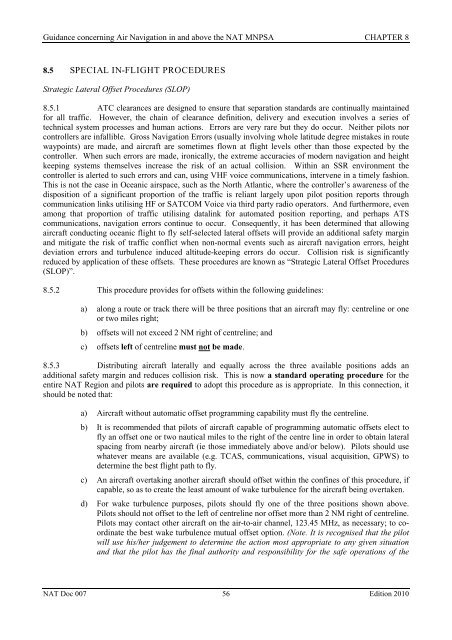World Air Ops | NAT | Doc 007 MNPS Guidance
World Air Ops | NAT | Doc 007 MNPS Guidance
World Air Ops | NAT | Doc 007 MNPS Guidance
You also want an ePaper? Increase the reach of your titles
YUMPU automatically turns print PDFs into web optimized ePapers that Google loves.
<strong>Guidance</strong> concerning <strong>Air</strong> Navigation in and above the <strong>NAT</strong> <strong>MNPS</strong>A CHAPTER 88.5 SPECIAL IN-FLIGHT PROCEDURESStrategic Lateral Offset Procedures (SLOP)8.5.1 ATC clearances are designed to ensure that separation standards are continually maintainedfor all traffic. However, the chain of clearance definition, delivery and execution involves a series oftechnical system processes and human actions. Errors are very rare but they do occur. Neither pilots norcontrollers are infallible. Gross Navigation Errors (usually involving whole latitude degree mistakes in routewaypoints) are made, and aircraft are sometimes flown at flight levels other than those expected by thecontroller. When such errors are made, ironically, the extreme accuracies of modern navigation and heightkeeping systems themselves increase the risk of an actual collision. Within an SSR environment thecontroller is alerted to such errors and can, using VHF voice communications, intervene in a timely fashion.This is not the case in Oceanic airspace, such as the North Atlantic, where the controller’s awareness of thedisposition of a significant proportion of the traffic is reliant largely upon pilot position reports throughcommunication links utilising HF or SATCOM Voice via third party radio operators. And furthermore, evenamong that proportion of traffic utilising datalink for automated position reporting, and perhaps ATScommunications, navigation errors continue to occur. Consequently, it has been determined that allowingaircraft conducting oceanic flight to fly self-selected lateral offsets will provide an additional safety marginand mitigate the risk of traffic conflict when non-normal events such as aircraft navigation errors, heightdeviation errors and turbulence induced altitude-keeping errors do occur. Collision risk is significantlyreduced by application of these offsets. These procedures are known as “Strategic Lateral Offset Procedures(SLOP)”.8.5.2 This procedure provides for offsets within the following guidelines:a) along a route or track there will be three positions that an aircraft may fly: centreline or oneor two miles right;b) offsets will not exceed 2 NM right of centreline; andc) offsets left of centreline must not be made.8.5.3 Distributing aircraft laterally and equally across the three available positions adds anadditional safety margin and reduces collision risk. This is now a standard operating procedure for theentire <strong>NAT</strong> Region and pilots are required to adopt this procedure as is appropriate. In this connection, itshould be noted that:a) <strong>Air</strong>craft without automatic offset programming capability must fly the centreline.b) It is recommended that pilots of aircraft capable of programming automatic offsets elect tofly an offset one or two nautical miles to the right of the centre line in order to obtain lateralspacing from nearby aircraft (ie those immediately above and/or below). Pilots should usewhatever means are available (e.g. TCAS, communications, visual acquisition, GPWS) todetermine the best flight path to fly.c) An aircraft overtaking another aircraft should offset within the confines of this procedure, ifcapable, so as to create the least amount of wake turbulence for the aircraft being overtaken.d) For wake turbulence purposes, pilots should fly one of the three positions shown above.Pilots should not offset to the left of centreline nor offset more than 2 NM right of centreline.Pilots may contact other aircraft on the air-to-air channel, 123.45 MHz, as necessary; to coordinatethe best wake turbulence mutual offset option. (Note. It is recognised that the pilotwill use his/her judgement to determine the action most appropriate to any given situationand that the pilot has the final authority and responsibility for the safe operations of the<strong>NAT</strong> <strong>Doc</strong> <strong>007</strong> 56 Edition 2010
















